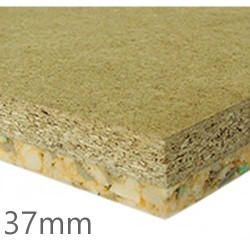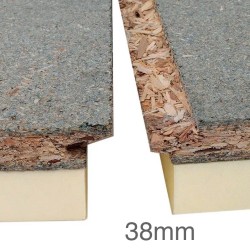Chipboards
The chips are formed into a mat and are then pressed between heated platens to compress and cure. The finished panels are then sanded and cut to size. They are not normally suitable for exterior applications. There are moisture resistant panels classified for use in humid conditions. While such panels may be resistant to periods of short-term wetting or high humidity, this does not mean that the panel is waterproof and direct wetting should be avoided. While chipboard is not normally attacked by wood boring insects, it can be subject to fungal decay under prolonged wetting.
Chipboard has smooth, sanded surfaces, which is achieved by increasing the panel density at the faces by the use of smaller wood particles with a larger percentage of resin binder compared to the core of the panel. Usually, the chipboard has a pale straw colour, but may be dyed according to industry practices, for example green for chipboards with enhanced moisture resistance, or red for boards treated with flame-retardant chemicals.
Chipboard density varies depending upon the timber species and the process used in manufacture, typically are between 600kg/m3 to 680kg/m3. The typical sizes are 1830mm 1200mm, 2440mm 1220mm, 2750mm 1220mm, 3050mm 1220mm, 3660mm 1220mm and in thicknesses of 2.5mm, 3.2mm, 6mm, 8mm, 9mm, 12mm, 15mm, 18mm, 19mm, 22mm, 25mm , 30mm and 38mm. Boards are produced with either square or T&G edges.
Chipboard has good mechanical performance, which is the same along and across the panel. They are appropriate for use as floor decking, either on timber joists or as a floating floor system. Different grades of chipboards are available for domestic to industrial usage, including both platform and raised access floors. The higher grades are used in industrial storage systems.
Chipboard differs seven technical class grades:
- P1 - general purpose boards for use in dry conditions,
- P2 - boards for interior fitments (including furniture) for use in dry conditions,
- P3 - non load-bearing boards for use in humid conditions,
- P4 - load-bearing boards for use in dry conditions,
- P5 - load-bearing boards for use in humid conditions,
- P6 -heavy duty load-bearing boards for use in dry conditions,
- P7: -heavy duty load-bearing boards for use in humid conditions.
Chipboard can be cut by a hand saw or power saw and machined - bored, planed, routed and spindled, planed with normal woodworking machinery. Conventional woodworking fixings and techniques can be applied.
- Ensure the joint parts are accurately machined.
- Use sharp cutters to avoid tearing or burnishing the surfaces.
- Use a high solids content adhesive with low flowing properties.
- Mate the panels accurately and hold them under pressure while the adhesive sets.
- Limit the width of grooves machined to about one-third of the thickness of the chipboard. The depth of groove is typically about one-half of the panel thickness.
- Allow adhesive-bonded joints to condition for several days before sanding and finishing.
- Ensure the fit of the joints is not too tight to avoid a split along the edge.
- Apply the glue liberally to both the tongue and the groove to ensure the entire joint is bonded.






































































































































